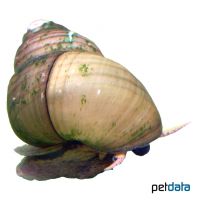River Snail (Viviparus viviparus)
| River Snail Viviparus viviparus | |
|---|---|
| Name | River Snail |
| Name Lat. | Viviparus viviparus |
| Family | River Snails |
| Family lat. | Viviparidae |
| Order | Snails & Slugs |
| Order lat. | Architaenioglossa |
| Origin | Europe |
| Habitat | Streams |
| Diet | Detritus, algae, plankton |
| pH | 6.5-8.0 |
| Behavior | Peaceful |
| Keeping | Group |
| Care Level | Easy |
| Reproduction | Viviparous |
| Breeding | Difficult |
| Life Span | 6-13 years |
| Protection | No |
| Metric Units | |
| Size | 4 cm |
| Temperature | 4-22 °C |
| Hardness | 5-15 °dH |
| Aquarium | 60 l or pond |
| US Units | |
| Size | 1.6" |
| Temperature | 39-72 °F |
| Hardness | 89-267 ppm |
| Aquarium | 15 gal or pond |
Distribution and habitat
The blunt swamp cover snails are widespread in Europe, from Ireland to western Russia and from southern Scandinavia to Greece. Theyl live mainly in large, slow-flowing waters with muddy soft bottoms and only rarely in lakes and ponds.
Maintenance
The pond should be furnished with pond, floating and oxygenating underwater plants (milfoil, waterweed, hornwort, etc.), large river pebbles, and a graveable substrate of round-grained gravel and sand.
When maintaining in a cold water aquarium (from 60 cm / 54 l), care should be taken to ensure that, in addition to border planting, a lot of free bottom surface is available with a deep, graveable substrate of sand and gravel, which should be covered with etaws foliage (oak, beech, etc.)
No ammonia, ammonium and nitrite should be detectable in the water and the nitrate value should be below 100 mg/l. When using a filter, make sure that no animals can be sucked in. The lighting must correspond to the natural day-night rhythm of the animals.
Diet
Swamp cover snails feed on dead plant material (detritus) and algae growth, which they pick up with their rasping tongue (radula) and filter food (plankton) from the breathing water. When keeping them in an aquarium, additional granulated or tablet food should be fed, as well as commercially available liquid or powdered plankton food for filter feeders.
Behaviour and compatibility
They are completely peaceful and should be kept in a group of 4-6 animals. Socialization with fish and crayfish, which do not consider these snails as food, is well possible. Because of food competition they should not be socialized with other filter feeders (mussels) in the aquarium.
In principle, only mutually compatible species with similar requirements for water quality and water temperature should be socialized.
Reproduction and breeding
They are separately sexual and viviparous. Outside the mating season, males and females are hardly distinguishable, females are slightly larger
The right antenna of males is remodeled into a short, columnar thickened mating organ. In the female snail, up to 30 young of various ages grow simultaneously in the uterus. The embryos feed on the nutrients in the egg. The oldest one is then born separately. The young are 5-8 mm in size and have a smooth shell edge.
Important
They are gill snails and have a lid to close the shell when needed
If the blunt swamp lidded snails are overwintered in the pond, it is necessary to provide sufficient depth and oxygen supply (filter, oxygen dispenser, ice free holder). They bury themselves in the mud, close the shell opening with the lid and go into hibernation
A regular partial water change is recommended, even if the pollutant load has not yet reached the upper limit. Sudden changes in water quality should be avoided. Newly introduced animals must be accustomed slowly to the water in the aquarium or pond.
Further literature can be found in your pet store.
References
Text: Barbara Pachner; Image: petdata
Source: BITTER (2008), Schnecken-Fibel, Dähne Verlag; ENGELMANN & LANGE (2011): Zootierhaltung - Tiere in menschlicher Obhut: Wirbellose, Verlag Harri Deutsch
